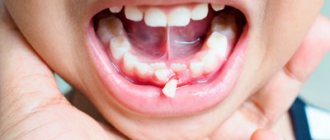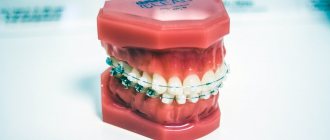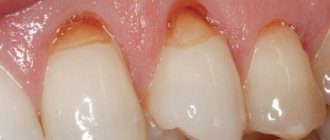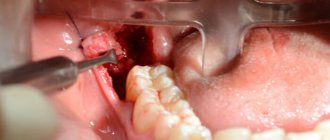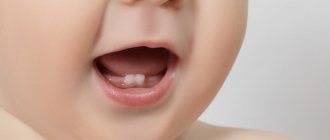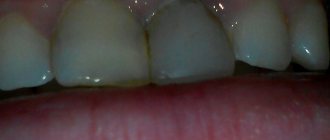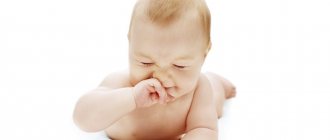- Crooked teeth
- The appearance of a second row of teeth in the jaw
- When permanent teeth do not appear for a long time
- How to distinguish baby teeth from permanent ones?
The complex process of replacing baby teeth with permanent ones is often painful and accompanied by a number of problems. The most common of them is malocclusion. The second most common problem is the appearance of a second set of teeth. Also, many parents are faced with the fact that their child’s molars and incisors do not appear for a very long time.
Crooked teeth
If permanent teeth begin to grow unevenly, you need to come for a consultation with an orthodontist at the A-Medic Network of Medical Clinics as soon as possible. The sooner such a decision is made, the easier it will be for the dentist to correct their growth. An incorrect bite is not only inconvenient, it can lead to the development of a number of diseases, for example, caries, stomach diseases, and cause childhood and teenage complexes and psychological problems.
The easiest way to straighten your jaw is to wear braces. It is very important for parents, together with the attending physician, to explain to the child that temporary inconveniences when using braces are justified and will bring invaluable benefits in the future. You need to take good care of it, because it will stay in your mouth for at least six months. This design will work most effectively during adolescence. Small children can more easily tolerate plates or trainers, which look something like boxing mouthguards, rather than braces. Children's enamel is quite delicate, so trainers that do not damage it will be the best way to correct a child's malocclusion.
Types of violations
Among the types of violation of the order and timing of eruption, two forms are distinguished - early and late. If a baby is born with teeth, they are usually removed. Early teething is said to occur when children begin to develop teeth at 4 months. Late teething is said to occur if at the age of 11-12 months the baby still has a toothless mouth.
More serious disorders include the incorrect order of teeth erupting, which entails an incorrect bite and lack of space in the dentition. For example, early molars that erupted may not leave room for the 4th and 5th teeth, and the eruption of the canines simultaneously with the first molars may cause the canine to move forward or backward.
The appearance of a second row of teeth in the jaw
Each canine, incisor and molar has its own place, but sometimes a child's permanent teeth begin to form a second row. This often happens when the milky ones have not yet fallen out, but the radical ones have already begun to appear. An undeveloped jaw that provides too little room for growth can also be a source of the problem. The third reason is that the incisors and canines in the second row are “superfluous”, or supernumerary.
The second row of teeth is not only inconvenient, but also unsightly, so the problem needs to be solved. A baby tooth that does not fall out in time can be removed in the clinic. If the reason for the formation of the second row is underdevelopment of the jaw, then the dentist can remove several teeth and install braces on the remaining ones.
Features and anomalies during the eruption of baby teeth. Why and what to do?
The period of teething is one of the most difficult in infancy. Especially if the baby has problems. In this article we are not talking about fever, cough, runny nose and diarrhea during teething. We will focus on more serious troubles. And they, lately, are becoming more common and different. And the most harmless of them is that the child’s teeth grow crookedly. This happens often in children. Now we will only talk about baby teeth! Permanent teeth are a separate matter.
Milk teeth rarely grow crooked. More often, parents are concerned about the spaces and gaps between their baby teeth. In both cases, it’s okay. The fact is that the rudiments of baby teeth are formed in the first months of pregnancy. On a small jaw, the teeth are located close to each other. As the jaw grows, the teeth move away from each other and uniform gaps form between them. If the gaps are uneven - very large (three), this may indicate the absence of individual teeth or uneven growth of the jaws - contact your dentist.
If a child has a crooked tooth growing, or baby teeth are growing very crowded, there may be several reasons:
- poor nutrition of the mother during pregnancy, when tooth buds were forming;
- lack of calcium, microelements, vitamins in the child’s diet (with a monotonous diet);
- insufficient load on the baby's teeth - when feeding only liquid, ground food after 8-10 months. It is imperative to let your child chew apples, carrots, peels, and dried fruits on his own;
- chronic diseases of the nasopharynx: runny nose, tonsillitis, adenoids, which provokes constant mouth breathing;
- bad habits: pacifier, finger sucking, sleeping with a pacifier in the mouth, bottle feeding after a year. It is necessary to teach your baby to drink from a cup, eat with a spoon, and chew age-appropriate food sooner.
All these factors, as well as heredity, can cause improper growth of baby teeth. Crooked baby teeth can only be treated by a pediatric dentist, who can assess the complexity of the problem, because often the teeth straighten on their own as the baby grows. But there is no need to rely on this, because you may miss more serious problems. After all, crooked baby teeth in children - photo can cause improper growth of the rudiments of permanent teeth, and therefore their curvature, loss from the dentition, etc.
There are other features of the growth of baby teeth. The most common:
- increasing the spaces between teeth. The large gap between the upper frontal incisors is a consequence of the deep location of the maxillary frenulum. Consult an orthodontist at the Utkinzub clinic;
- the black edging of the cervical zone of the teeth is a violation of the absorption of iron, which provokes increased proliferation of leptotrichia bacteria. Treatment by a dentist and treatment of the cause by a pediatrician;
- yellow-brown teeth already when teething ( the child grows dark teeth ) is the result of the mother’s treatment with tetracycline antibiotics during pregnancy (tetracycline teeth);
- greenish staining of baby teeth – metabolic disorders, in particular bilirubin. Also observed in hemolytic diseases associated with the destruction of red blood cells. A complete medical examination is indicated;
- Red baby teeth occur with the disease “porphyria” and appear as a result of a violation of the metabolism of porphyrin - a red pigment. A complete medical examination is indicated.
- gray, soft teeth – lack of enamel coating, hypoplasia. Appears when the mother has a malnutrition during pregnancy or as a result of metabolic disorders in the child. Contact your dentist.
Other developmental anomalies of the dental system may be associated with genetic diseases, constitutional causes, congenital developmental anomalies, and tumors. (“Absence of milk teeth – adentia. Second row of teeth”) All the above-described cases of abnormal development, including crooked teeth in children , are a reason to contact a pediatrician and pediatric dentist as soon as possible. The sooner the cause of the anomaly is identified, the greater the chances of quickly and effectively correcting the situation and guaranteeing the child a full, healthy life.
When permanent teeth do not appear for a long time
The absence of permanent teeth for too long can be due to several reasons: these are the genetic characteristics of the body, their immaturity, and the destruction of tooth germs by some kind of infection.
Only a dentist can determine the true cause. At the A-Medic Network of Medical Clinics clinic, they will take a picture of the jaw, which will show how the child’s permanent teeth are formed. Sometimes they can grow inside the gums. If nothing is visible on the image, the doctor may suggest solving the problem by installing dentures.
Causes and consequences of dental pathology
Abnormal two-row growth is possible for many reasons:
- heredity;
- chronic colds and decreased immunity;
- unhealthy diet with a predominance of soft foods and purees;
- lack of vitamins and useful elements;
- premature removal of milk units;
- disturbance in the location of tooth germs.
With timely treatment, the orthodontist will easily straighten the bite and place each tooth in its proper place. If you delay visiting a doctor, the consequences can be serious:
- malocclusion;
- problems with hygiene and the development of caries;
- facial deformation due to jaw imbalances;
- ugly smile.
A sign of a potential shark jaw is the absence of gaps between the teeth in a 4-6 year old child. Insufficient space is the first prerequisite for the appearance of a second row of teeth in children and a signal for an attentive parent.
It is easy to see an incorrectly growing tooth, especially in the lower jaw. During the period of change in bite, dentists recommend monitoring the process - periodically conducting home or professional examinations and listening carefully to the baby. Complaints of discomfort in the mouth, inconvenience of chewing and pain indicate the need to visit a dentist to assess the condition of the oral cavity.
How to distinguish baby teeth from permanent ones?
Both molars and baby teeth have a similar structure, but have a number of external differences.
- Thus, milk ones are on average lighter and whiter than permanent ones, which are distinguished by a yellowish enamel tone.
- On average, a molar is larger than its primary tooth.
- Permanent ones have a thicker layer of hard tissue and a less developed pulp.
- Dairy varieties have thinner and shorter roots.
It is important for all parents to remember that both baby and permanent teeth of children must be protected, and any problems that arise in their growth and development must be resolved immediately. Specialists from the “A-Medic” network of medical clinics can help them with this.
Teething order
To know what an incorrect order of teething is, you need to start from the norm and schedule of their appearance. So, they should appear in the baby in this order:
- Most often, the lower and then the upper incisors appear (from 4-5 to 9-10 months).
- This is followed by the lateral lower and upper incisors (from 7-8 to 11-12 months).
- The first chewing teeth on top and bottom appear at the age of 12 months to one and a half years.
- Fangs on both jaws appear between the ages of one and a half to 2 years.
- The last chewing teeth appear on both jaws, starting from 18 months to 2 years.
By age 2, your baby should have 20 baby teeth (10 on top and 10 on bottom).
What should mom do?
When teeth erupt out of order, every parent should take this fact seriously. Pediatricians advise feeding your baby in a balanced manner. For six-month-old children, mother's milk is not enough. Complementary foods should be introduced gradually. Mothers should properly allocate time for wakefulness and sleep, and visit the doctor according to the schedule. A vitamin complex may be prescribed. It is prohibited to select medications on your own, since only a doctor can give an objective assessment of the baby’s condition.
If the chewing organs do not appear according to the calendar, specialists prescribe certain tests to determine the cause of the failure. Mom should not neglect the doctor's recommendations. Its instructions should be followed exactly to stimulate the appearance of units. To do this you need:
- Include foods rich in vitamins in your diet;
- Correctly create a daily routine and monitor its implementation;
- Conduct comprehensive physical exercises with children;
- Regularly visit a doctor for preventive purposes;
- Treat illnesses in a timely manner;
Taking medications without a doctor's recommendation is dangerous and detrimental to a child's health. Only care and affection, proper care and feeding will allow you to raise a healthy child.
Should I brush my newly erupted teeth?
Dentists strongly recommend starting to take care of oral hygiene from infancy. For newly emerging teeth, they offer special silicone brushes or wipes. A simpler option is a finger wrapped in gauze. You can simply moisten it with water or use toothpastes for children under 3 years of age (they are marked 0+ and can always be swallowed). The main thing when brushing your teeth is no violence! A little more cleanliness isn't worth the stress.
| Author Fedor Katasonov | Scientific editor Maria Gantman |
What to do when children are teething?
The most natural and one of the most reliable ways to reduce pain is cold. Pick up an item - a “rodent” that can be put in the refrigerator. Freezing them is not recommended because it can damage the baby's delicate gums.
Often children prefer to gnaw on their parent's finger or, unfortunately, on their mother's breast. But parents may not have enough patience for a long time, so it is better to find a suitable teether.
It should be:
- whole and durable (the child should not bite off pieces that could cause choking);
- without ropes and beads (the rope can pinch the neck or break, creating a risk of choking on a bead);
- without paint with toxic components;
- just clean (no need to disinfect it).
You can refrigerate the fruit puree or put a few wet cloth toys in the refrigerator so you can replace them.
Of course, children chew not only objects that are ideal for this. But if with a teether made of one piece of silicone or a mitten with a silicone pad the child can be left alone in the playpen for some time, then with a bunch of small objects on a string around the neck or a bracelet made of beads, the same as with some fruit or vegetable, you need to look after it.
If cooling does not help, and the stress of teething is very severe, discuss taking pain relievers and fever reducers (ibuprofen is most often used) with your pediatrician. To be on the safe side, consult your doctor, but a single dose by weight (for ibuprofen is 10 mg/kg), given once at night for 3-4 days of active teething, will not cause harm.
What to do if your teeth are cutting incorrectly
First of all, don't panic. When your toddler's teeth are cut out of order, balance his diet. After 5-6 months, a child, in addition to mother's milk, should receive complementary foods. It is important to measure the time of wakefulness and sleep. It is necessary to take the baby to the pediatrician for examination in a timely manner. If he prescribes a complex of vitamins, you must take them. Self-selection of medications can harm the child’s health.
The baby should be examined by a pediatric orthodontist. If there are no developmental pathologies, there is no need to worry. An objective assessment of the condition is the main criterion of health. If units emerge out of order, doctors advise observation and not skipping preventive examinations. When a one-year-old baby’s chewing organs do not grow, this is a reason for examination. This situation indicates a disturbance in metabolic processes. Violations in the order of birth of teeth should be closely monitored and reacted only if necessary.

